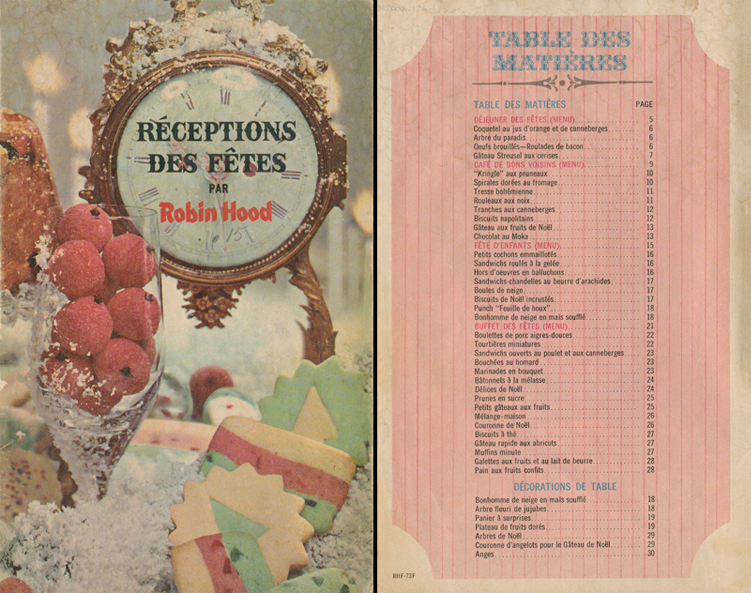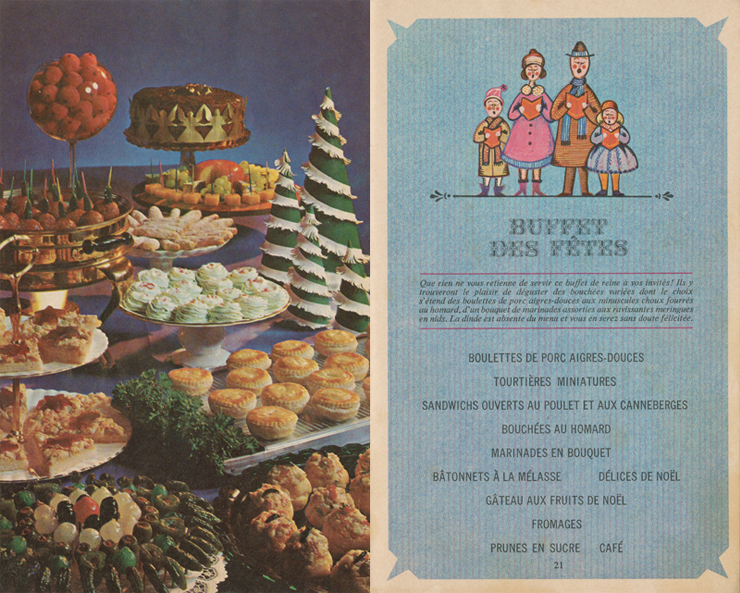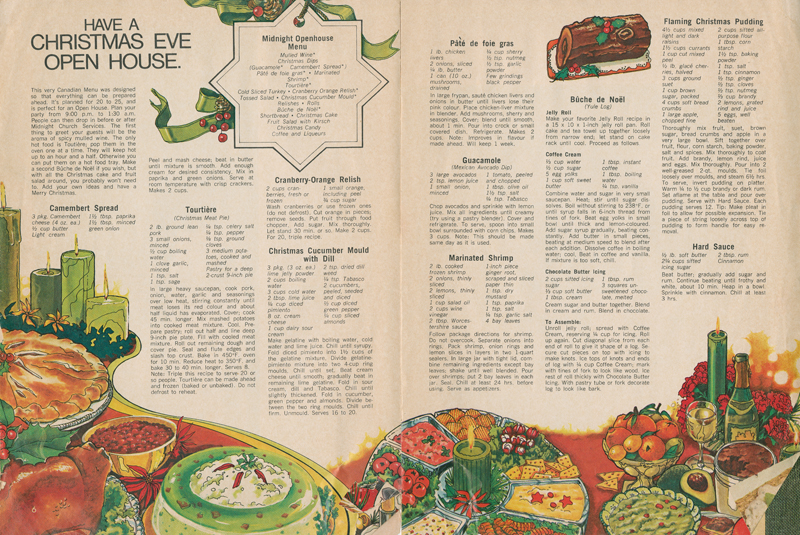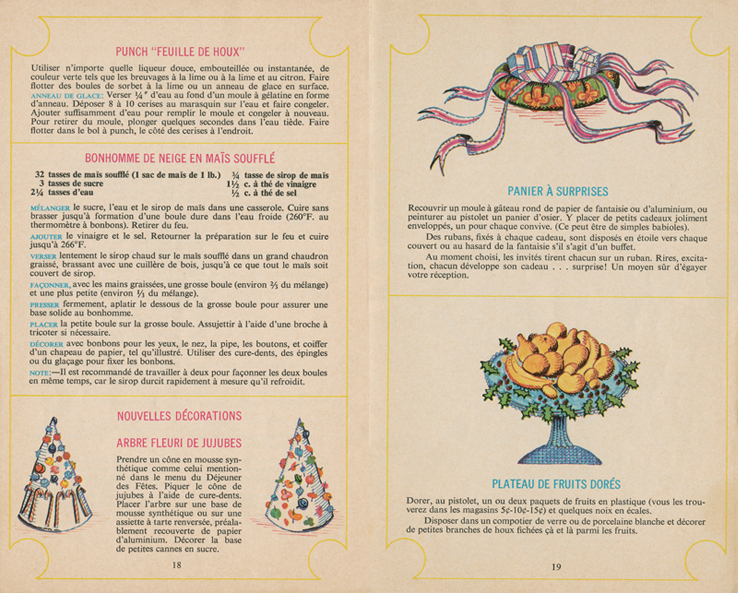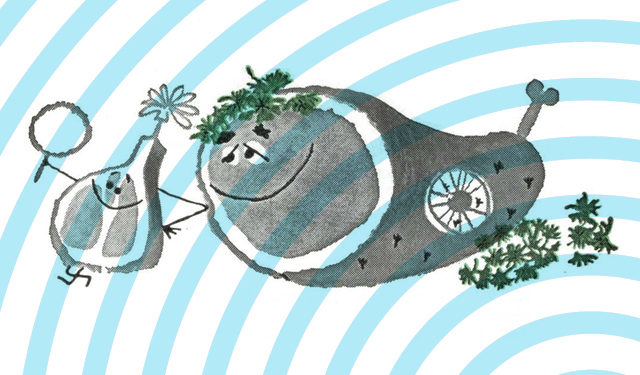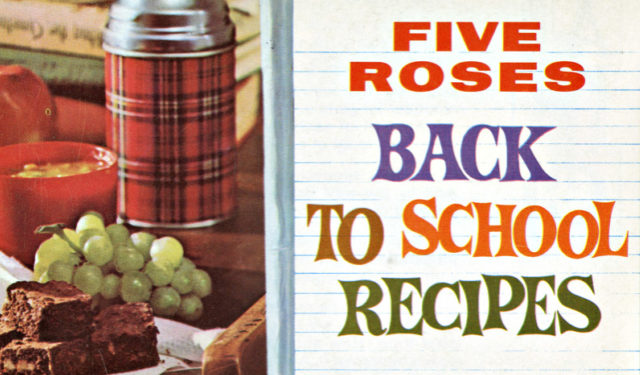Holiday Meals, from Meat Pie to Vegetable Aspic
Colourful recipe booklets reveal original holiday dinner suggestions from another era.
December 1, 2020
This series of 12 articles written for the Shared Emotions project uncovers feelings, sensations and values buried in archival documents and looks at how they are shaped by the cultural and historical context of the time. For this very special holiday edition, our intern Alexis Curodeau-Codère has scoured the archives for holiday recipes designed to both tantalize the taste buds and heighten the senses!
______
Meals hold pride of place in our childhood Christmas memories. I remember the smell of candles and the aroma of meat pies and pâtés baking in the oven. I also recall the sound of the baster my aunt used to keep the turkey nice and juicy, the texture of the stuffing, the creaminess of the mashed potatoes, and the hours my mother spent preparing and browning a mountain of meatballs for the stew.
Some recipes to put on your holiday menu!
If I go back even further in time, I can envision the whiteness of the tablecloth and the softness of the three cushions I had to perch on to reach my plate when I was little. Along with the same dishes and aromas, these memories return every year, superimposed one upon the other like layers of puff pastry, enriching our lives with the passing years.
All the same, culinary traditions have been updated over time. Just like fashion, socioeconomic conditions and even our personalities, holiday meals undergo subtle changes from one year to the next. Some dishes are modified, some are added to the menu, and others disappear.
Our relationship to food evolves, gourmet and aesthetic trends come and go, families change and so do practices. It seems to me, there is a constant tension between tradition and the ever-shifting present, between wistful memories of the past and the desire to try something different and reinvent the holiday meal. In the early 2000s, for example, desserts in a jar sometimes replaced Yule logs, and nowadays millet pie is an increasingly common substitute for meat pie.
What did the holidays look like for those who grew up in the 1950s and 1960s?
Recipe pamphlets preserved in the McCord Museum’s collection provide an interesting, surprising and sometimes even comical look at the holiday meals of another era.
This eclectic festive buffet features miniature meat pies alongside lobster appetizers and paper Christmas trees. It promises a compromise of sorts between holiday culinary traditions and a desire for modernity, as evidenced by this passage from the booklet: You will undoubtedly be commended for the fact that turkey is not on the menu.
This feast boasts a traditional tourtière, served with cranberry sauce, an essential condiment to any Quebec holiday meal. However, the classic meat pie is also accompanied by an impressive vegetable aspic, a dish that was very popular in North America, especially in the 1950s, though it could still be found on holiday tables in the early 1980s. The textured filling and flaky pastry of the meat pie goes well with the light, savoury moulded gelatin salad. The setting is also striking for its colour scheme. The green aspic, holly leaves and candles complement the red cranberries and other decorations. On this table, the presentation of the dishes is as important as the taste, combining visual beauty with gustatory pleasure.
Surprisingly, these booklets do not simply provide festive recipes, they also suggest a host of table decorations like plastic fruit, paper angels and pyramids of fruit. In some cases, the aesthetic of the dishes seems to take precedence over taste, in order to provide a multi-sensory experience. There are also tips and tricks for hosting a successful holiday party. The suggestion seems to be that applying gold spray paint to a dish of plastic fruit and decorating a foam cone with gumdrops are as important to meal preparation as cooking the food itself.
Above all, these recipe booklets remind us that while the holidays are indeed the ideal opportunity to celebrate our traditions and create new memories, they are primarily a chance to enjoy a heartwarming culinary experience in the presence of others, regardless of the shape, texture, aroma or taste of what is being served.
TO LEARN MORE
- To learn more about What’s cooking in our archives! A taste of the past project
- To learn more on the Recipes and Food Collection (C265)
- To learn more on the Shared Emotions project
- To learn more on the Textual Archives Collection


